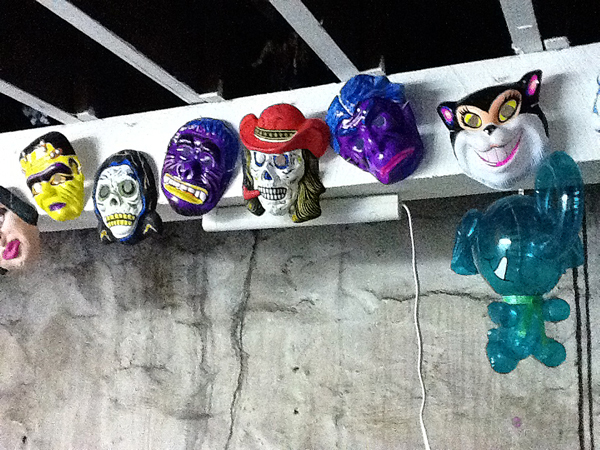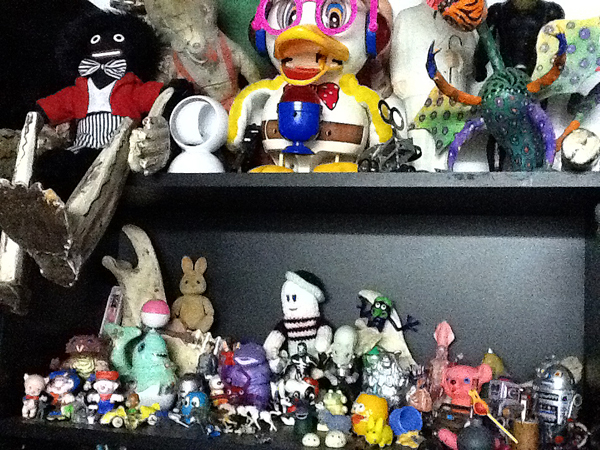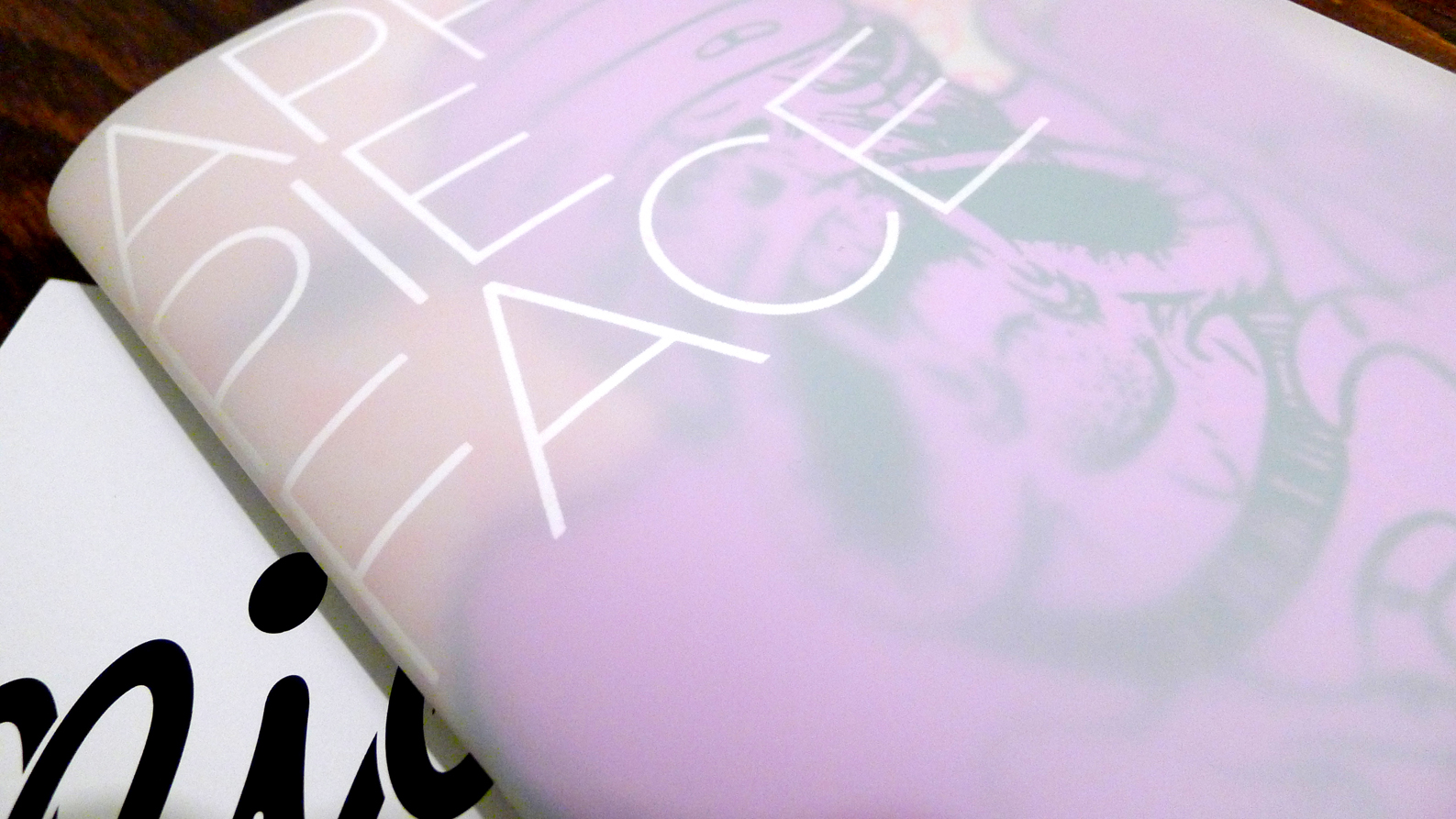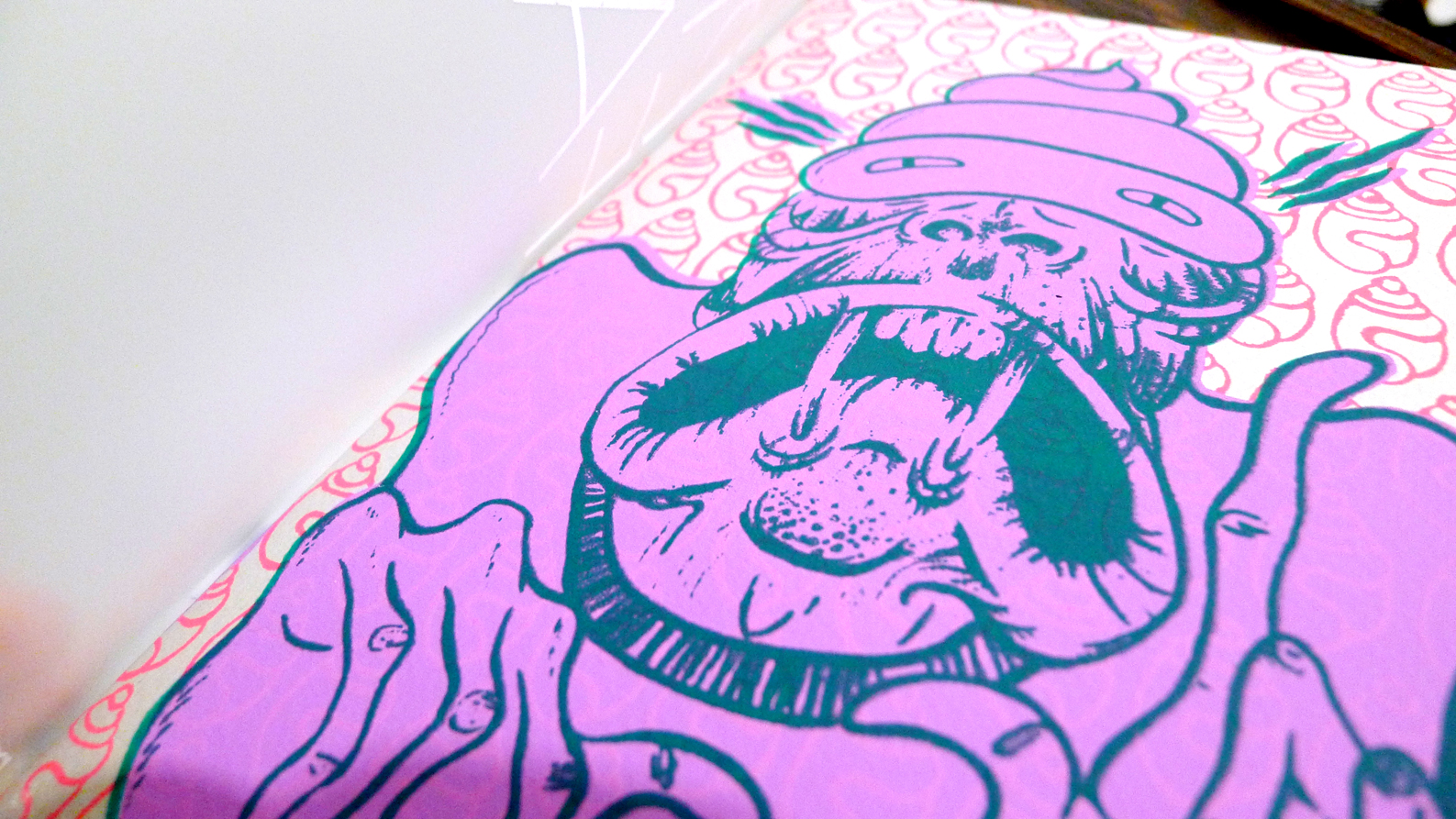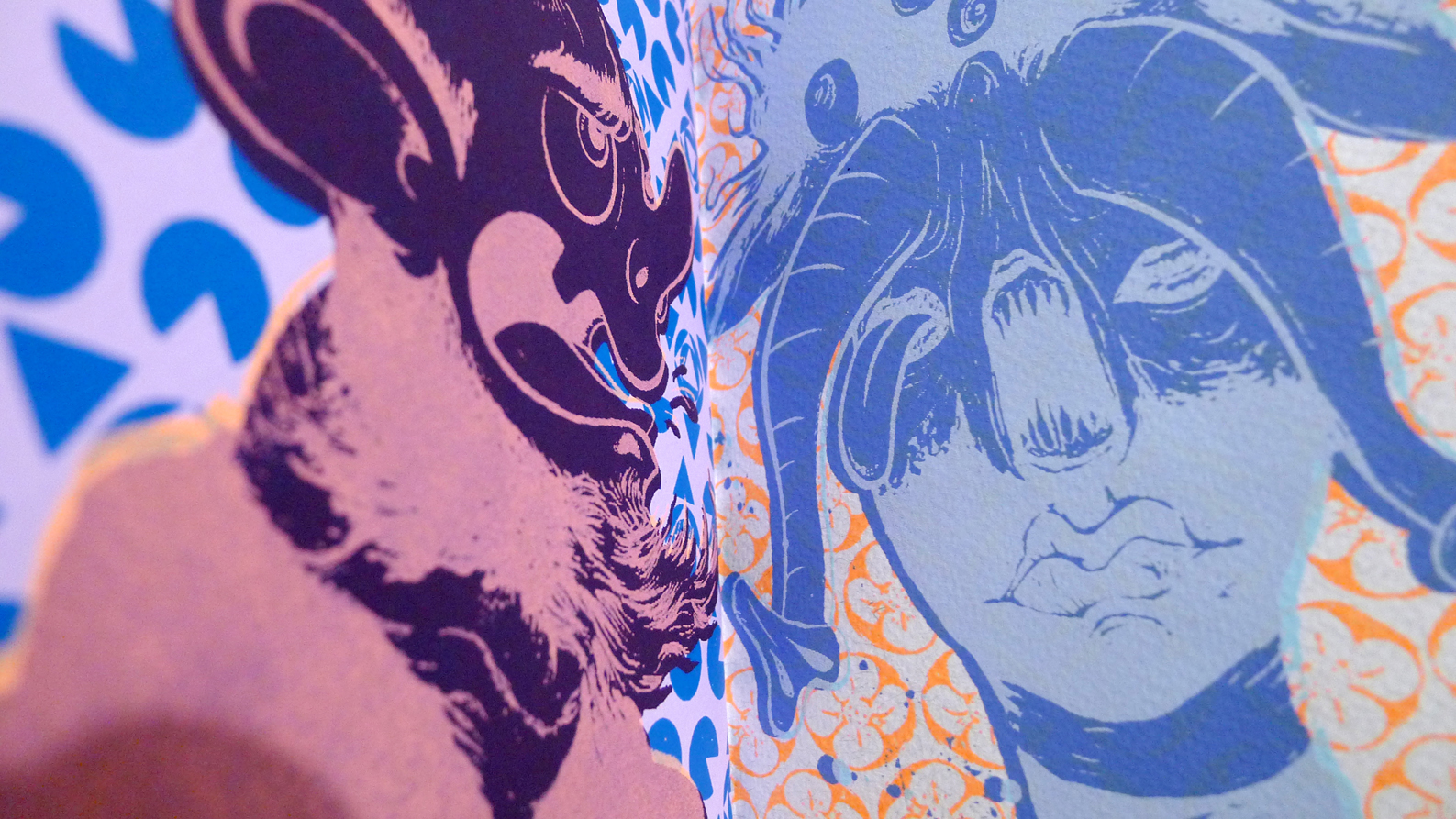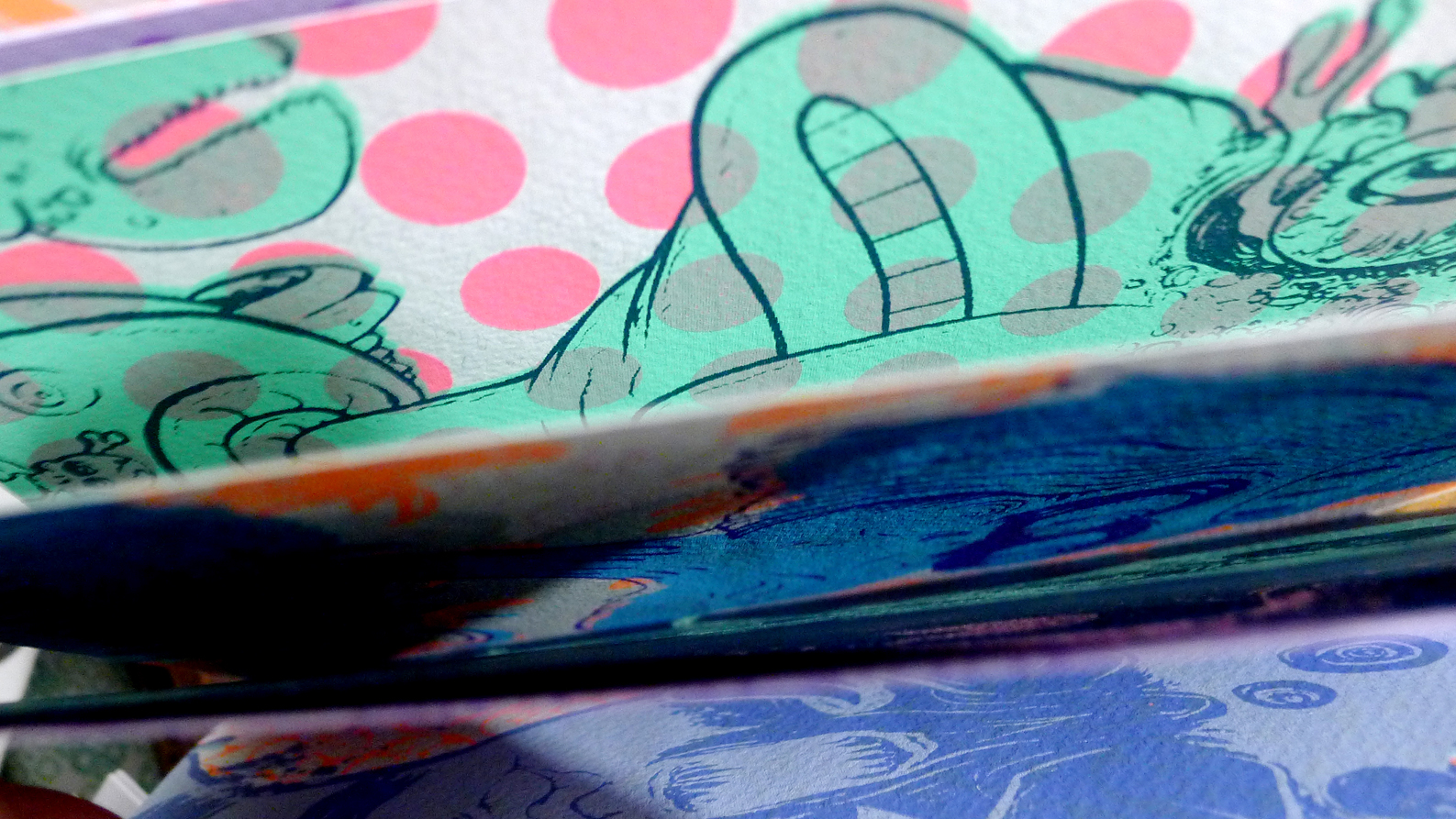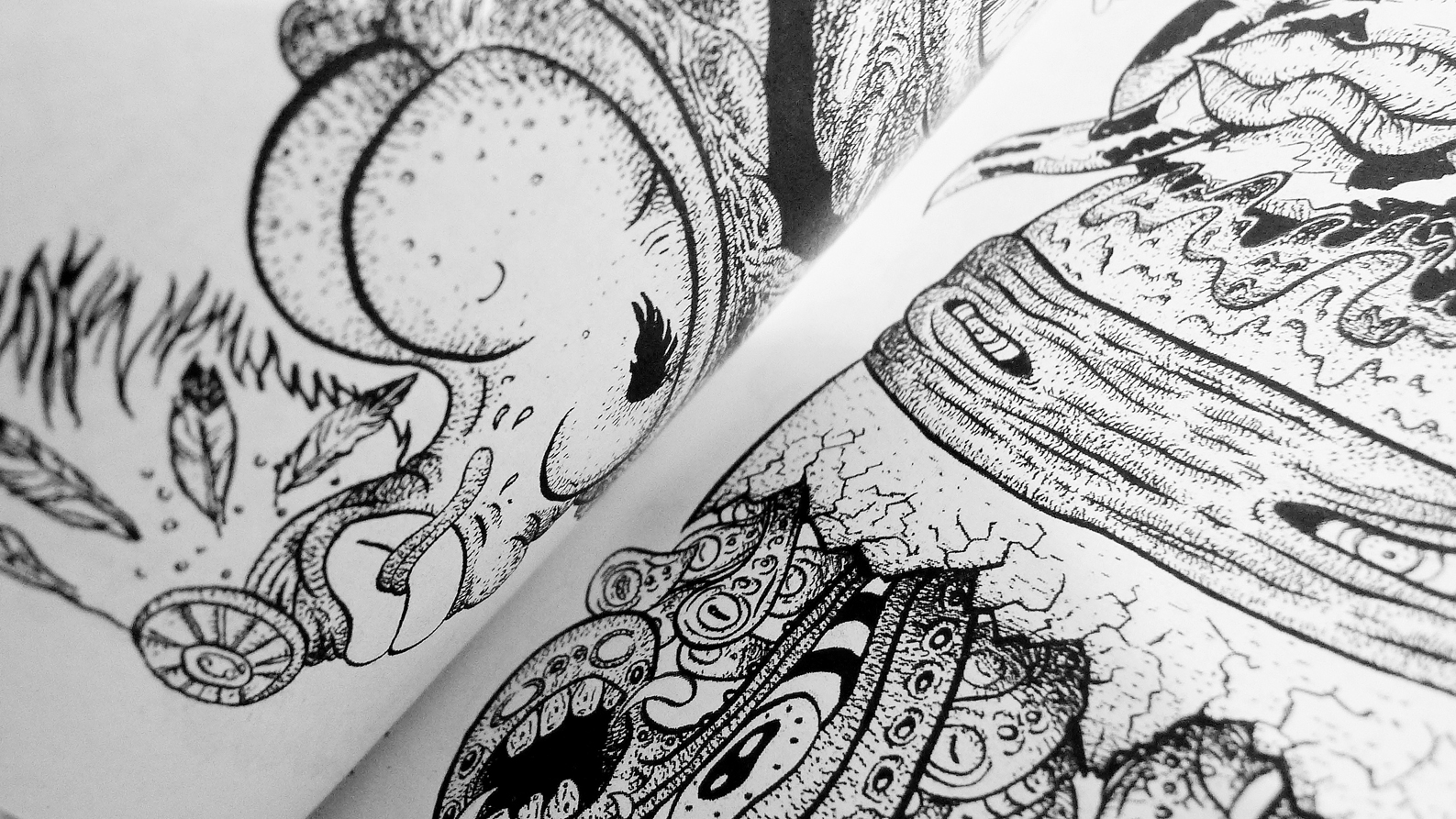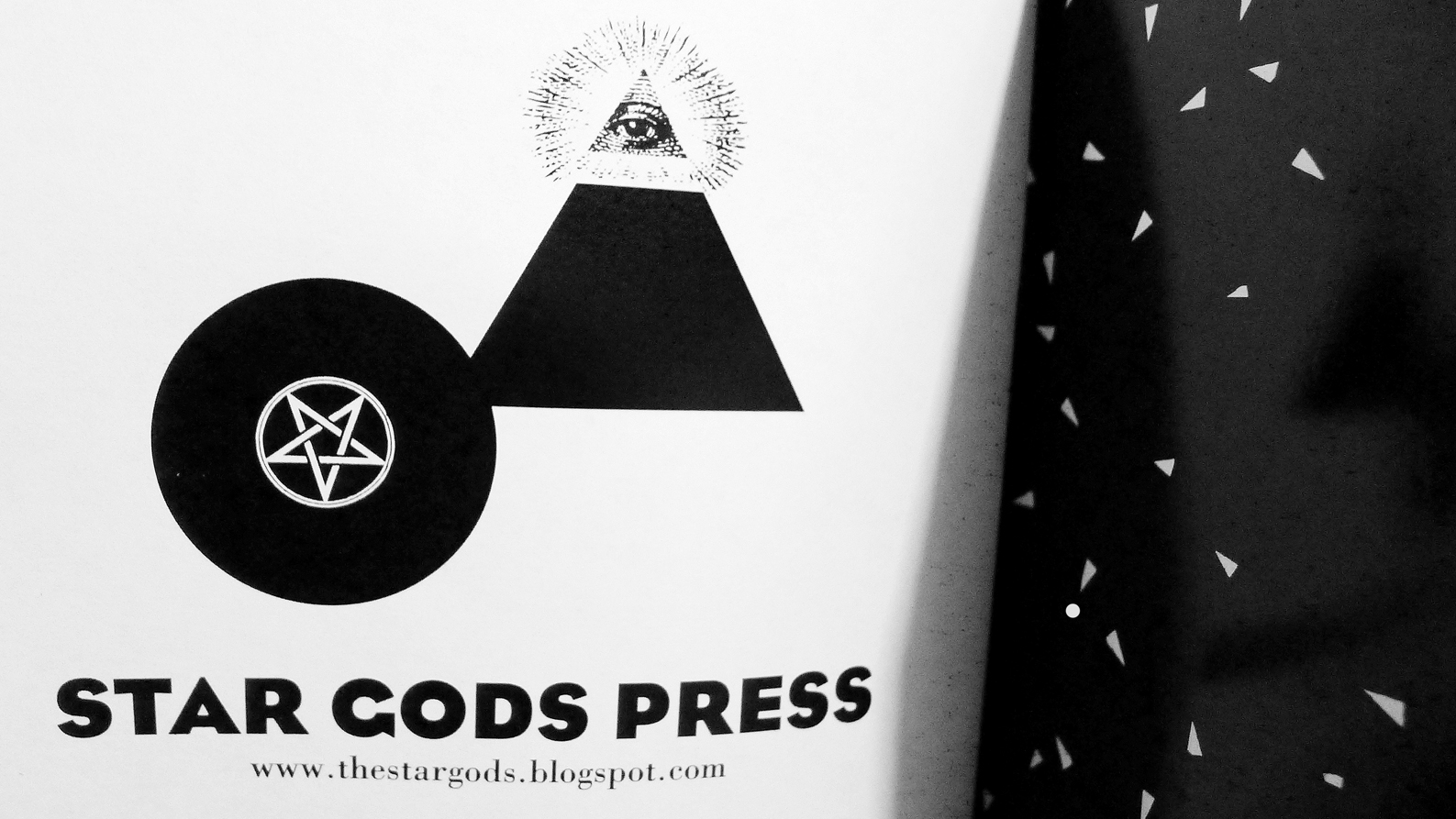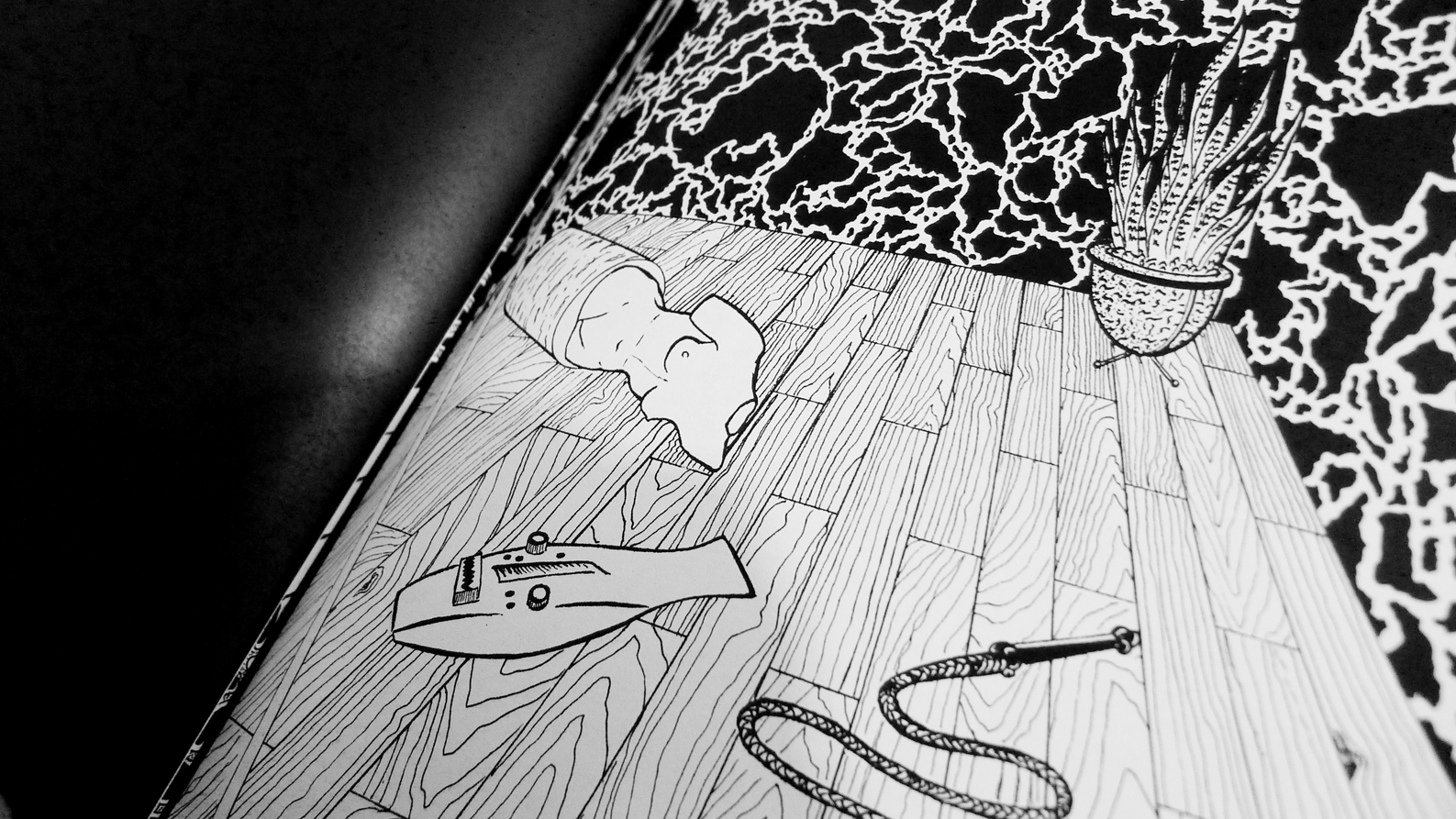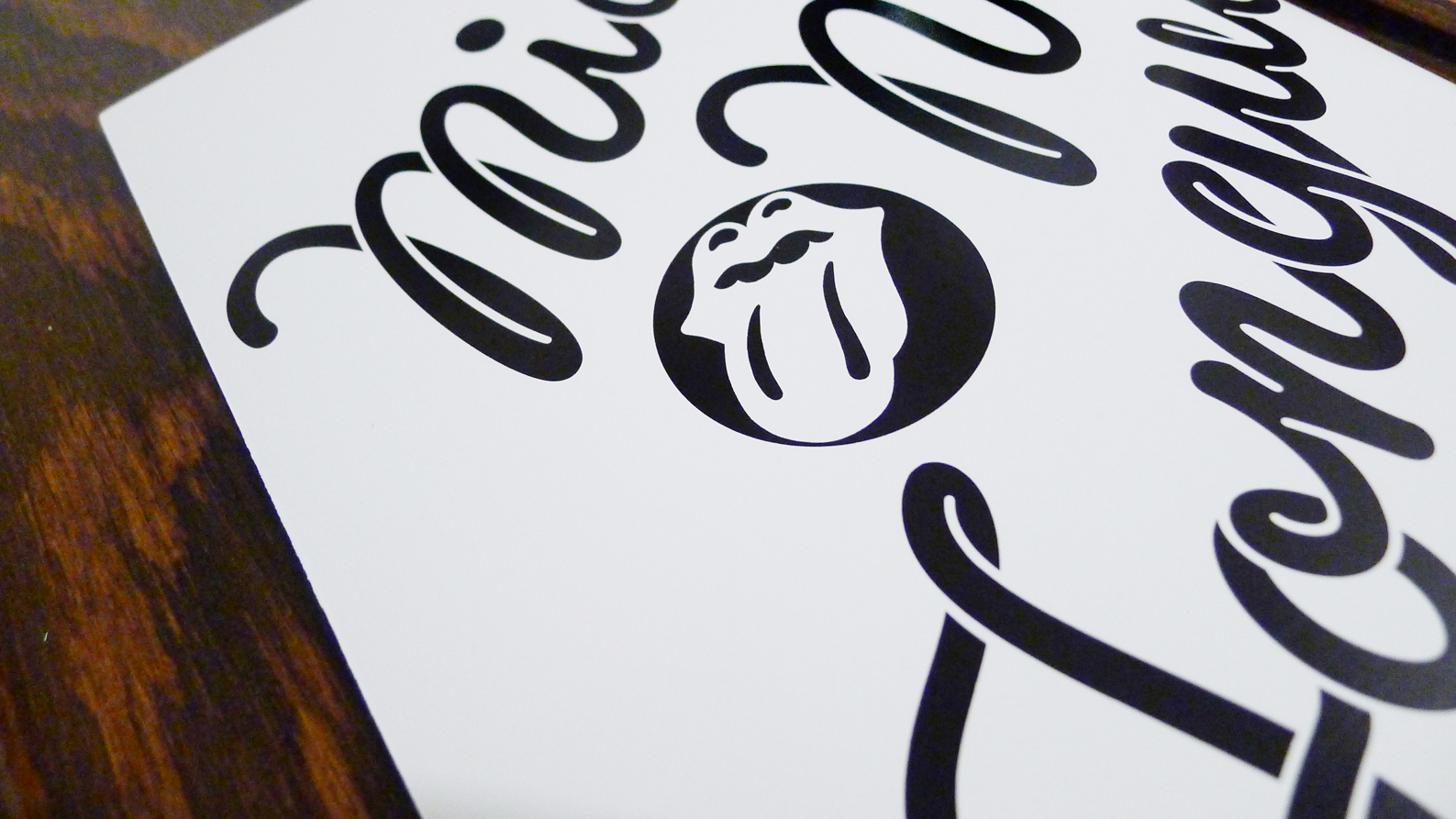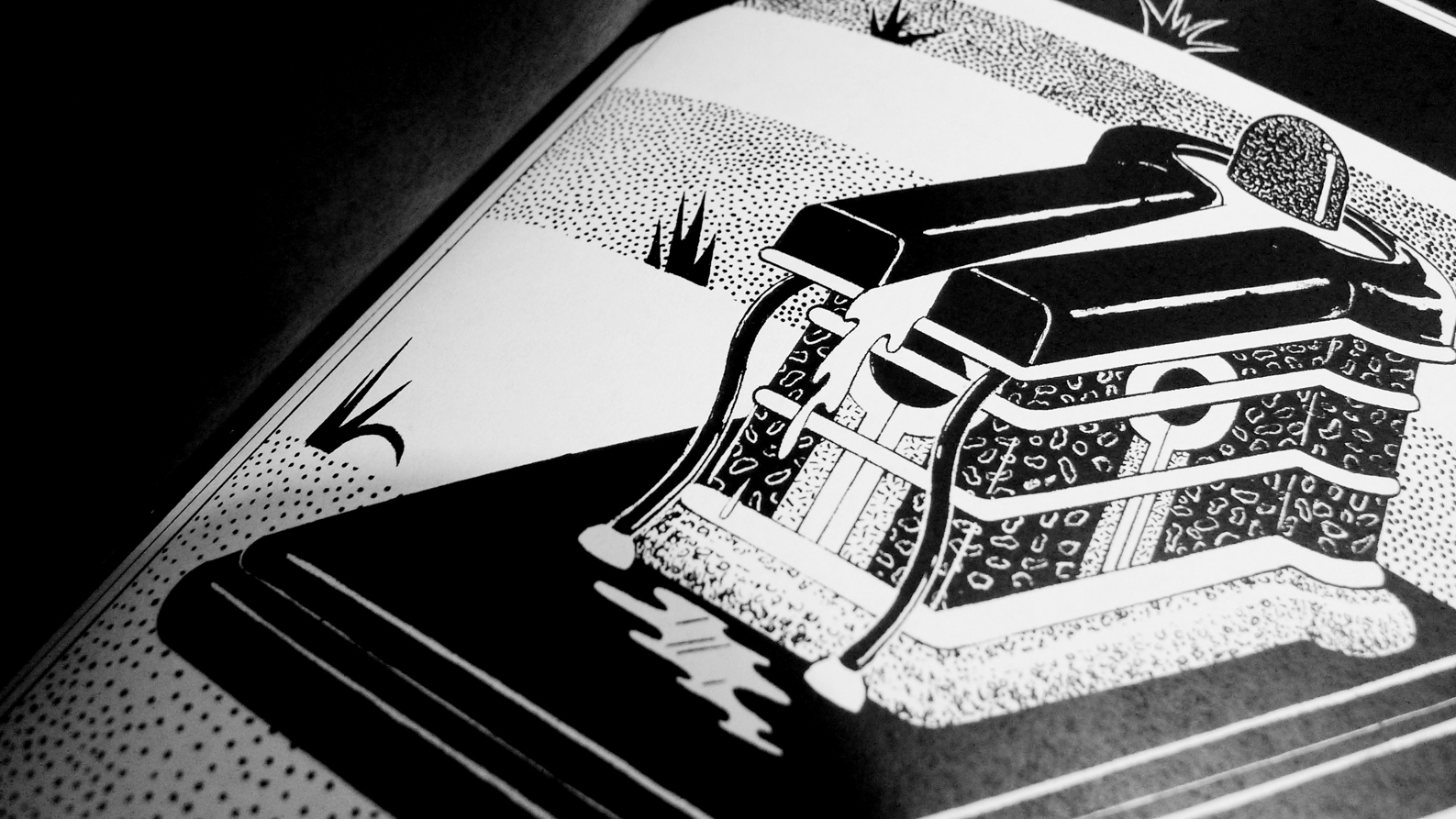Star Gods Press is Daniel Giantomaso, Morgan Spry-Young and Nathan Jones: three artists/designers/makers living and working in downtown Vancouver. They have been publishing art zines for years now and their latest, Mid-Nite Tongue is a black-and-white cyborg fantasy. Another mini, Skulls, is a collection of Nathan’s line drawings. I met them in their studio to talk about their books, process and future projects.
(Above: Star Gods studio decor.)
Melissa Luk: So how many zines have you made? What’s your zineography?
Morgan Spry-Young: There’s three…
Daniel Giantomaso: Well there’s four with Nathan’s own.
MSY: White Swallows is our collaboration.
DG: Then Star Gods Binaries is me and Nathan.
MSY: And Star Gods Press is what we’re publishing them all under, which came out of Star Gods.
DG: We don’t have anything ready yet, but we’re working on a fifth for this girl in Brooklyn who asked us to help out.
ML: What’s the background story?
MSY: Well, we all met at Langara College in the fine arts program in 2001.
ML: Did you all do printmaking?
DG: I took screen-printing, and you [Morgan] did [printmaking].
MSY: Nathan did, probably…
DG: I don’t think Nathan did. No, Nathan didn’t because we had to teach him when we were doing Apple Pie Face and it was infuriating.
ML: So how did all this start?
DG: Nathan and I did a bunch of drawings, and then we thought, what are we going to do with this shit? That was two years ago.
ML: Oh, that’s not long!
DG: No, but we’ve been drawing forever. So, this was the first. We split the page in three and kind of did it exquisite corpse style. After we were done we went back into each others’ drawings a little. There’s lots of thumbprints and stuff.
ML: So what made you decide to publish instead of showing them in a gallery?
DG: I don’t know… there’s not really a lot of calls for… I mean, you can put your illustrative art in galleries here, but nothing happens. No one buys anything.
ML: And people buy books?
DG: Exactly. Nathan also wanted to try to screen-print. So that was for Apple Pie Face.
MSY: The second one went along with your show in March.
DG: Those were made for an art show that we planned with some friends. We just wanted to make books, I guess. It makes what we do accessible and it kind of makes it for a purpose.
Especially that one. Somebody sent it to this guy in Oregon and then I met him in Seattle randomly. It was like, Oh you’re that guy. Because you’ve made something cheap that you can just pass around, people get to know you from all over the place. So now we know quite a few people in the States, all of a sudden, that want to work with us or just talk to us.
ML: Is that how the girl in Brooklyn connection happened?
DG: Yeah. She was liking our stuff. I was posting it on Tumblr, and then she sent in a message.
ML: Oh, literally she was “like” ing it on Tumblr. I thought you meant she was feeling it. That’s cool because normally when people like things on Tumblr, they’re just reblogging pictures. It’s really refreshing to see, you’re an artist too!
DG: Funnily enough, we’ve got a Big Cartel thing now, and everything we’ve sold has been to the States and it’s all been illustrators or animators. Every single one who’s bought it. I think it’s an economy in that way, for artists.
Oh there’s Nathan. [to Nathan] Did you bring Skulls?
Nathan Jones: I brought four of them.
DG: That’s the fourth one.
ML: Oh, OK. I was wondering what you could have meant by that… [laughs]
ML: These are really nice drawings. You should totally hang them. Sometimes I find it hard to tell if it’s a drawing when it looks like this, with all the fine lines and correcting, when you look at a reproduction.
DG: Everyone uses so much Photoshop these days that you don’t know what they’ve edited or not.
MSY: We haven’t really done any Photoshop.
DG: No. Our intent has always been to make it right in the first place.
ML: In terms of object-making, how do you approach that? Like, why the plastic wrap? Or how do you decide you want it glow-in-the-dark, like the cover of Binaries?
NJ: They’re all sort of different things. So with the plastic wrap, I think it’s just because people like things that are wrapped in plastic.
MSY: It keeps it clean and makes it more special.
NJ: It does sort of tie in to the whole novelty idea, and this idea of collectibles which is what we’re getting at with the glow-in-the-dark sort of stuff.
DG: We’ve been pretty gimmicky, but on purpose.
NJ: It’s a nostalgia for things we appreciated when we were growing up. There was this time in the 90’s when all these comic books were coming out and they all had silver covers or…
DG: Holograms…
MSY: It was fun.
NJ: It was a nostalgia for that and also a play for what grabs people.
DG: That all goes along with the monster stuff too. Do you remember Topps chewing gum?
ML: Yeah! I was going to mention Garbage Pail Kids.
DG: All of that stuff was really ridiculous pictures and some gimmicks that went along with it. Like this sticker or a glow-in-the-dark scratch-and-sniff.
ML: Oh my gosh, scratch-and -sniff would be fun.
DG: [laughs] We figured out how to do that, that’s kind of our next one. Not to make it ourselves, but to get someone to do it.
ML: It would be fun if you scratched his nose and it smelled like pickle, his mouth would smell all rancid…
DG: You could have a scratch-your-own-adventure [laughs] Scratch your way through.
ML: What’s the name about: The Star Gods?
DG: I don’t know [laughs]. What was our deal?
NJ: We both have an interest in mysticism and a long time interest in the occult and mythology.
DG: It goes along well with monsters and surrealism.
ML: How about your influences as publishers/book makers?
DG: There’s a gallery and screen-print bookmaker called Bongoût in Berlin. It’s a French guy who lives in Berlin. I came across it when I was there and I really liked what they were doing. At the same time I found another one in France called Le Dernier Cri, who were the same kind of thing. Really well-done screen-printed comics. In France, the underground comics scene is really dark. Like, lots of monsters… and scary rape and stuff like that [laughs].
That’s what we were trying to do with that first book, and then after we kind of just started figuring other ways out.
NJ: We all knew about zines. It’s the idea of somewhere between the artist book and the accessibility of zine culture. A lot of old underground comics, like RAW comics, and what RAW did with publishing as well.
DG: That’s true. They were self-publishing and doing kind of weird, gimmicky stuff and making it stand out. Also, just doing something weird for the purpose of making a piece of art that you can own that’s cheap.
ML: Do you guys plan on doing comics?
DG: Yep. Morgan and I are doing a comic next.
MSY: I guess our influence for Mid-Nite Tongue a little bit was to make a grid. We’ve been trying to get into design and this was sort of generating ideas for that [laughs]. For some of the settings, we wanted to design things to put in there. We were looking at a lot of Art Deco…
DG: And early 80’s graphic design. It’s an aesthetic that I think is really contemporary again for some reason, I don’t know why. And not in a retro kind of way, but more like, this was actually really interesting and why didn’t we stick with this? Rather than making everything black, which was a lot of design for a long time. White and black and not much else.
ML: Did you have to learn art history stuff at Langara?
DG: Yeah lots. Actually at Langara you have to do more art history than anywhere else.
ML: So what’s your background [Nathan]? You went to Langara with them, but before that…
NJ: Before I went to Langara I was doing film work. Then after, I went on to Emily Carr to pursue painting mostly. Part of why the idea of making multiples appealed to me, was going through a painting history. When you do paintings, it’s this one large painting and it’s not affordable.
ML: And no one can touch it…
NJ: Yeah, there’s a preciousness to it, not like there isn’t a preciousness to these small books. But you can’t do one painting and give it to 20 of your friends.
ML: For future projects, do you guys have a timeline?
DG: If we can get two out a year from now on I’ll be proud, I’ll be happy.
ML: Does it come naturally to you guys?
DG: No. It’s a lot of fucking work [laughs]. It fucks up our whole life. I’m not even kidding.
MSY: The next project we’re planning on doing is a full-on collaborative anthology.
ML: Cool! It would be nice to feature Vancouver people. It’s weird because I have never heard of you guys before and you obviously have a lot of history and work coming out.
MSY: It kind of only evolved into a press this past fall.
ML: [laughs] Did you notice a shift happen, say, when you started the online store? Or from posting on Tumblr?
DG: All the cartoonists that started following us on Tumblr, yeah. And I sent some zines to Meathaus.
ML: I saw that review!
DG: They put it up there right after they got it. But he had already followed me on Tumblr anyway. I put up something of Alex Stursberg‘s. Have you heard of him? He did that Strathcona Artist Survey zine… Anyway, for the “Cheaper Than” show he did these four Disney collages. It’s these monsters made out of parts of Disney story books and they’re really good.
I posted those and Meathaus picked up on that, and I thought, Oh we should send our own stuff… [laughs]. Maybe that’s a good idea…
ML: Do you guys think about that though? Like growing the press more…
DG: Now – because people like it. I didn’t really expect anyone to like it.
You always evaluate yourself against other people and you think, I’m not very good… But I think all those mistakes you make are kind of like your signature. And other people don’t see them as mistakes, they see it as style. [Melissa laughs]
I think that’s what’s happening now. We’re still putting out something that is kind of different and the kind of people who are into illustration and comics are really into it.
Thestargods.blogspot.com to find photos, updates and their zines.

